While you can write Python with just a simple text editor, using a code editor or IDE with additional tools can skyrocket your productivity. However, it can be difficult to know which one is right for you: What features are important? Which is best for your particular use case? Are paid CEs or IDEs worth it?
Today, we'll answer all of these questions and more with an exploration of the top 10 Python editors and IDEs for 2021.
Here's what we'll cover today
-
What makes a good Python IDE or code editor?
-
Atom (CE)
-
Codespaces (CE)
-
Visual Studio (IDE)
-
Sublime Text 3 (CE)
-
Vim (CE)
-
IDLE (IDE)
-
Thonny (IDE)
-
Spyder (IDE)
-
PyDev (IDE)
-
PyCharm (IDE)
-
What to learn next
What makes a good Python IDE or code editor?
Integrated Development Environments (IDEs) is software that bundles all the tools you use for writing and testing their programs, all wrapped in a neat toolkit. Each IDE includes different tools, but each includes a text editor to write code, build tools for automatic compiling, and a debugger that points out potential errors.
Specialized IDEs can contain much more advanced tools as well, such as visual coding support and AI integration.
Code editors (CEs) are lightweight alternatives to IDEs. CEs contain tools to write code, like a text editor with automatic syntax highlighting and simple bug catching, but avoids the complex tools included in IDEs.
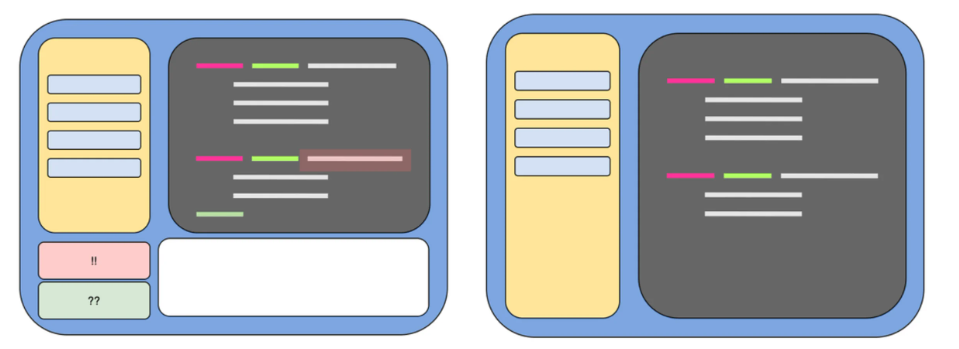 Image Source: Author
Image Source: Author
Features you need for a Python IDE or CE
-
Syntax highlighting: Automatic highlighting for different types of syntax is essential for readability, For example, all variable names are white, all keywords are orange, etc. so you can understand what you're looking at in just a glance.
-
Automatic code formatting: IDEs and CEs that support Python can automatically indent, add colons, and include missing end brackets all according to Python's style rules. This means you can spend less time fiddling with formatting and more time coding.
-
Debugging: While different tools vary in how hands-on the debugging process is, it's good to at least have the ability to step your code gradually to track changes. Ideally, you want a tool that will point out and highlight potential errors even before runtime.
-
Build automation: Your chosen tool should allow you to write and run Python code in the same window. Copy and pasting source code to external compilers to run it will cost you extra time and add unnecessary confusion.
-
Save and reload: All IDEs and CEs should include some way to save and reload code in the same state. The best tools go beyond this and include version control, which allows you to revert to previous builds if needed.
10 Best Python IDEs and Code Editors
The main trade-off when choosing an IDE or CE is customization vs setup time. The following lists are ordered from least to most customizable.
 Image Source: Author
Image Source: Author
General Purpose IDEs and Code Editors
 Image Source: Author
Image Source: Author
Atom (CE)
Atom is a more out-of-the-box ready open-source CE that strikes a balance between Sublime's performance/customization and a short setup time. Atom has a sleek look and is powered by Electron front-end framework, a tool for building desktop apps using JS, CSS, and HTML.
Atom has built-in support for beloved features like automatic code completion and find/replace. It is made by Github and can be easily integrated with Github and Git using built-in tools.
Atom features user plugins but allows you to quickly pick and integrate them hassle-free via Atom's free package marketplace. This marketplace lets you browse the most popular plugins to expand or fine-tune Atom to your needs.
Atom's main downside is that it is unpolished compared to other CEs. It has seen substantial updates since launch but still crashes occasionally. Unfortunately, updates have noticeably slowed since Microsoft acquired Github in 2018.
Pros:
-
Usable out of the box
-
Lightweight and Customizable through plugins
-
Easy plugin integration
Cons:
-
Slow startup time
-
Still comparatively unpolished with performance issues
-
Runs as a JavaScript process
-
Some essential features (debugger, code building, etc) must be added via a plugin
Use Case:
You're a multi-language developer who wants a free CE with extensive customization but doesn't want to spend too much time fine-tuning it.
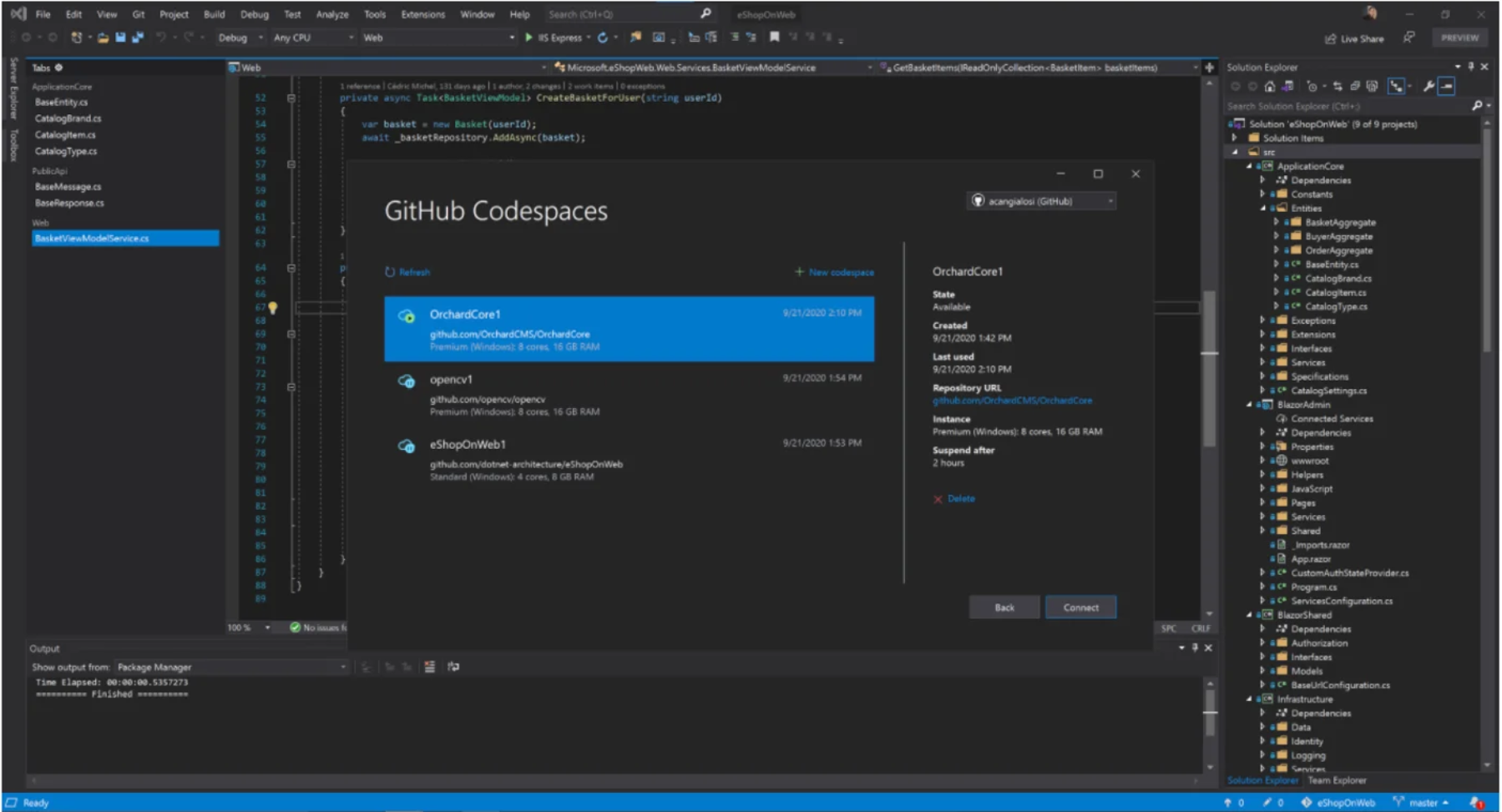 Image Source: Author
Image Source: Author
Codespaces (CE)
Developed by Microsoft and released in May of 2020, Codespaces is a new cloud-based cross-platform CE usable entirely in your browser. It includes a browser-based text editor and support for Git repositories, extensions, and a built-in command-line interface. It is even usable offline and will update once an internet connection is reestablished.
Codespaces can either be launched directly from Github or through a local install of Visual Studio. Codespaces is currently free but will include a paid option in the future.
Codespaces browser-based approach allows you to work from anywhere on any internet capable device. This makes it excellent for team projects because you no longer need to have a shared tool or pass around file copies.
The biggest downside of Codespaces is that it is new and unrefined. As with any new product, you could easily find a bug that doesn't have a fix yet.
Pros:
-
Good for team projects
-
Usable anywhere on any device
-
No install or setup
-
Integrated with Github from the ground up
Cons:
-
New and unpredictable
-
5 workspaces limit
-
Limited customization
Use Case:
You're a developer that often works on collaborative projects or contributes to open-source projects and don't mind limited customization options.
Visual Studio (IDE)
Visual Studio is a general IDE that supports Python through a plugin called Python Tools for Visual Studio (PTVS). Visual Studio has extensive features, with built-in support for Git, a built-in terminal, comprehensive unit test tools. It also has an extension marketplace similar to Atom.
Visual Studio also comes with Intellisense, widely considered to be one of the best autocompletion systems available to developers today. You can also add plugins to allow support for web dev tools like Flask or Django.
The download is quite large but is worth it if you use it for multiple languages. There is a free version (Community) and paid versions (Business/Enterprise) that offer extra perks like customer support and DevOps tools.
Visual Studio also has a lightweight CE called Visual Studio Code (VS Code).
Pros:
-
Full of features off the bat
-
Usable for many platforms and languages
-
Easy to add plugins
-
Intellisense autocomplete
Cons:
-
Extra resources behind a paywall
-
Heavy footprint for use with just Python
-
Not available for Linux operating system
Use Case:
You're a dedicated developer who changes languages regularly, wants to learn one tool for all your programming needs, and aren't too interested in visual customizations.
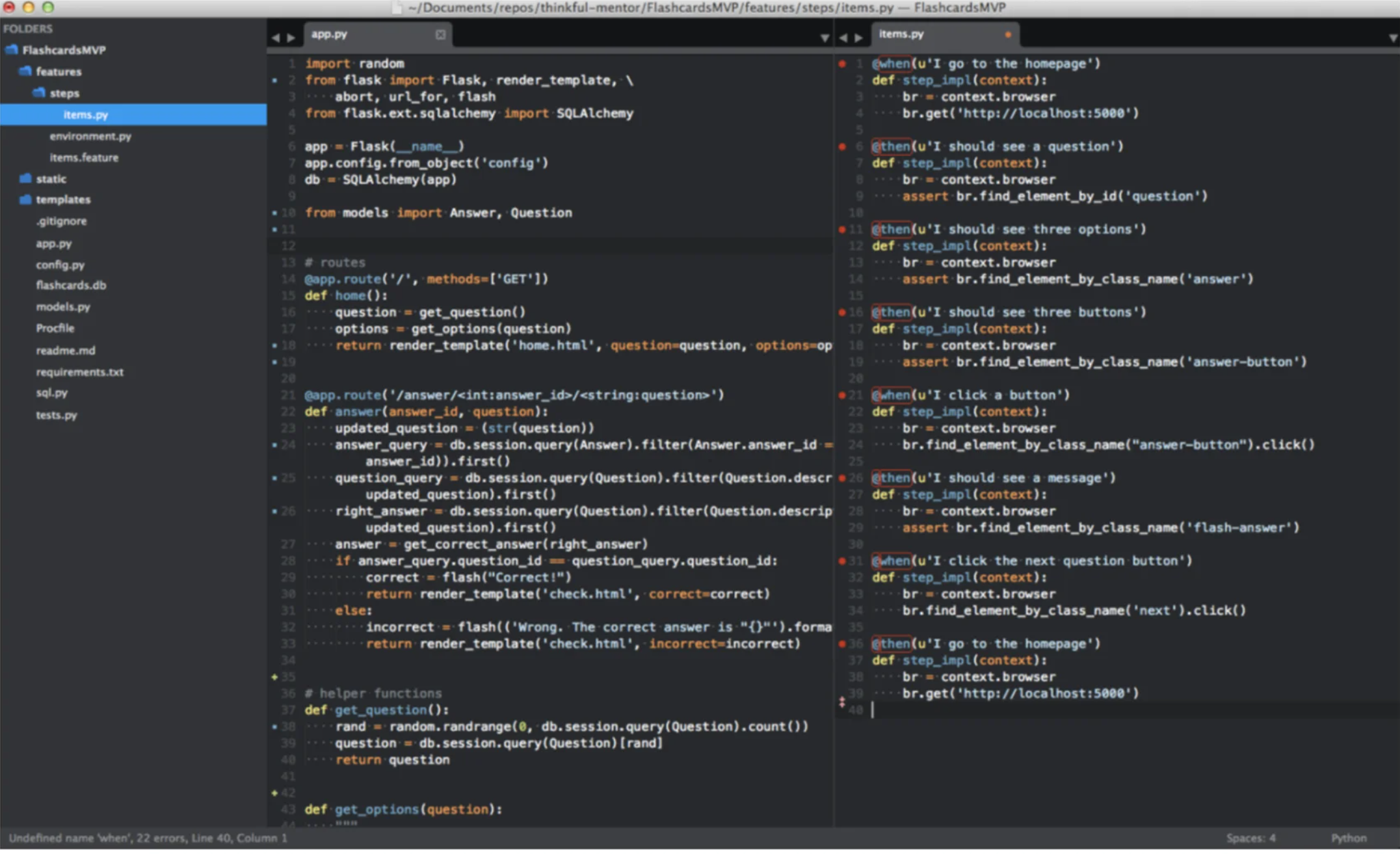 Image Source: Author
Image Source: Author
Sublime Text 3 (CE)
Sublime Text is a highly responsive code editor used by thousands of developers. Sublime text supports multiple versions of Python and allows you to set your version for each project.
Sublime is nearly unbeatable in speed, with all but the largest files opening instantly. Sublime's other call to fame is its extreme customization through user-built plug-in packages.
These plugins let you change nearly anything about the code editor, from appearance to error finding, code completion, additional language support, and more. More plugins are added each day, meaning Sublime is potentially one of the most updated tools available.
The main downside of Sublime is its $80 cost.
Pros:
-
Highly customizable through plugins
-
Unmatched speed
-
Great for working on multiple projects at once
Cons:
-
$80 price
-
Vanilla version missing features
-
Complicated to add plugins
Use Case:
You're a long time coder who wants a customizable but lightweight tool for all your favorite programming languages and are not afraid to take time to set it up.
 Image Source: Author
Image Source: Author
Vim (CE)
Vim is a classic code editor built as the successor to VI. It comes readily installed in Mac OS and Linux but is also available for download on Windows. It's known for a steep learning curve but serious payoffs. It's still readily updated but rarely sees stark changes.
Vim has nearly no UI by default and is operated entirely by the keyboard. This means you can use VIMscripts to customize anything in the tool from appearance to custom keyboard shortcuts. This marks Vim as potentially the most customizable and efficient CE once you've mastered it.
While efficient once learned, exclusive keyboard control is a tough transition to make if you're not coming from VI. The VIMscript customizations are equally difficult to pick up as they require that you complete a coding project before you even start!
Pros:
-
Keyboard control greatly increases coding speed once optimized
-
Programmable keyboard shortcuts for personalized optimizations
-
Fully customizable with VIMscripts
-
Available by default on Mac and Linux machines
Cons:
-
Notoriously difficult to pick up for beginners
-
Customization is a highly involved process
Use Case:
You're already used to VI and keyboard controls or want the most customizable and efficient editor regardless of the learning curve.
Python Specific IDEs
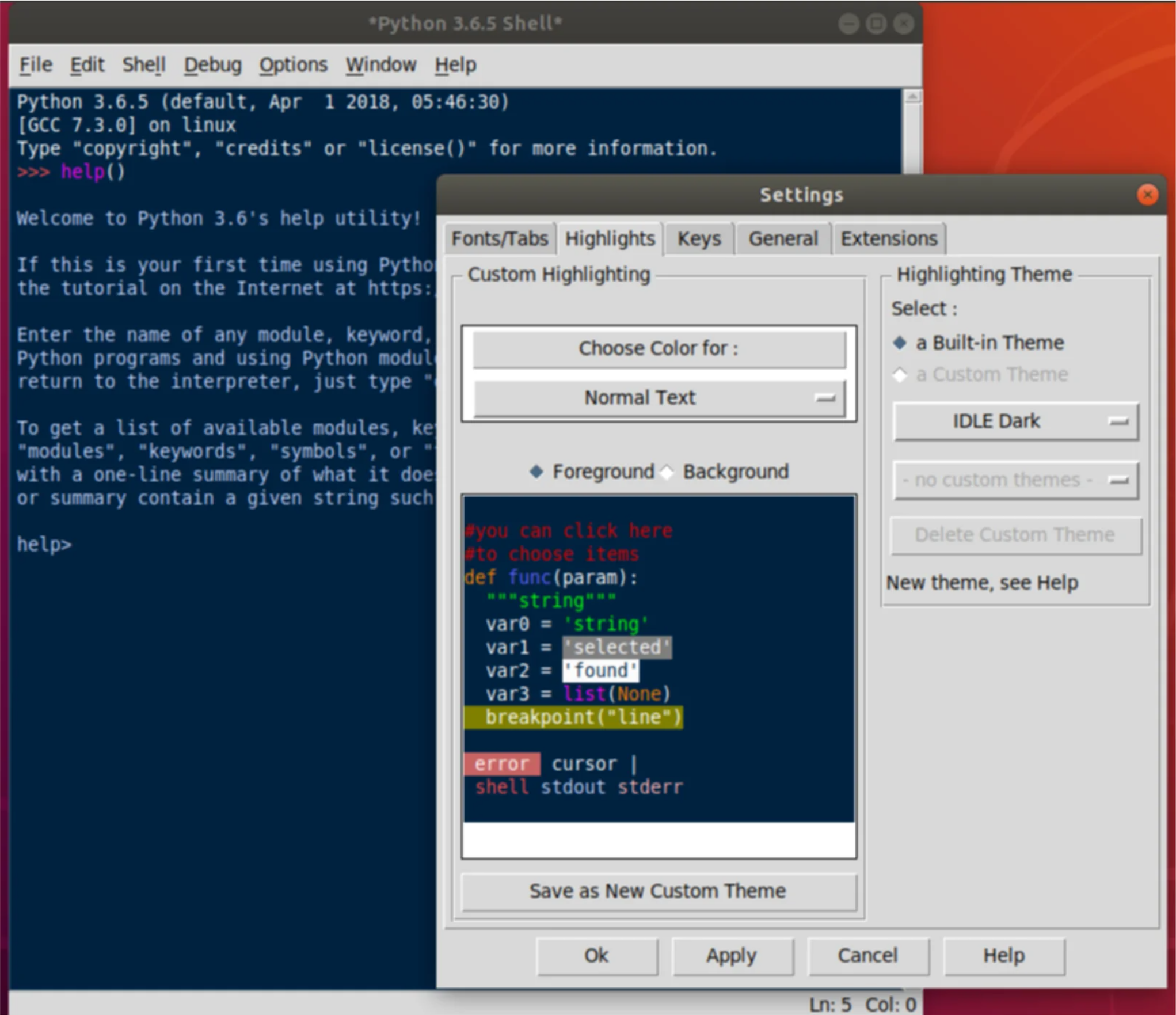 Image Source: Author
Image Source: Author
IDLE (IDE)
IDLE is the default IDE installed with Python. It includes all the core features like a Python shell window, autocompletion, highlighting, smart indentation, and a basic debug tool.
IDLE is a limited IDE designed for learners. It's lightweight and doesn't include much customization to avoid overwhelming new users. However, once you get to larger projects you'll find IDLE's performance and organization tools start to show their faults.
IDLE also does not have plugin support, meaning you can't expand it to meet your needs.
Pros:
-
Included with Python
-
Simple to pick up and use
-
Includes all the essential tools
Cons:
-
Poor performance on larger projects
-
Cannot be visually customized
-
Cannot add additional features
Use Case:
You're new to Python development and want to practice basic projects without setting anything up.
 Image Source: Author
Image Source: Author
Thonny (IDE)
Thonny is a free Python IDE designed as the ideal environment for beginners. The UI is simple and comes with highlighting, autocompletion, debugging, and auto-formatting built-in.
IT also has unique features for beginners like a variable value tracker displayed next to the main editor. All options are set with menus rather than config files to allow beginner developers to focus on their coding. Even plugin installation is optimized for beginners with a simple package manager.
The downside of Thonny is that it does not have the advanced features of IDEs like PyCharm or the specialized tools for specific applications available for Spyder. As a result, you'll eventually have to transition to another IDE once your programs become more complicated.
Pros:
-
Simple, non-disruptive user-interface
-
Customizable with menus rather than config files
-
Comes with top features, all optimized for beginners
Cons:
-
Missing specialized tools
-
Doesn't perform as well as advanced IDEs
Use Case:
You're a newer Python developer that wants more features than is offered by IDLE but don't want to jump to a more involved IDE yet.
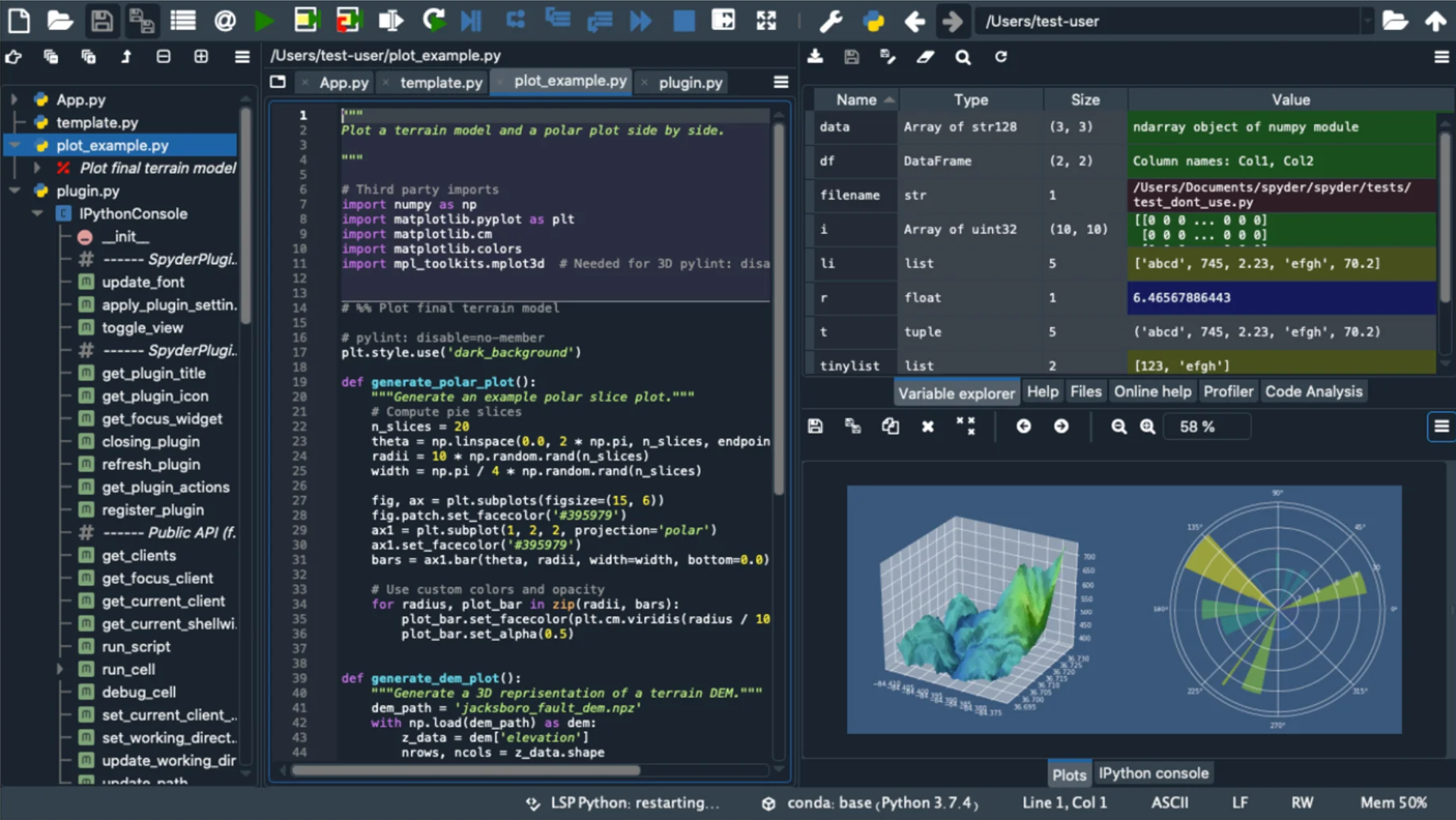 Image Source: Author
Image Source: Author
Spyder (IDE)
Spyder is a Python-specific IDE designed for data scientists and ML engineers. It's included with the Anaconda distribution that includes other popular Python libraries like Scikit-learn, Mumpy, Matplotlib, Scipy, and Pandas.
It includes great features like autocompletion, a powerful debugger, iPython shell, and limited data visualization tools. Spyder is specifically optimized for data science and therefore interfaces perfectly with all the top tools.
Spyder has fewer features than extensive IDEs like PyDev and rather focuses on providing a straightforward, easy to use tool for non-developers.
Pros:
-
Simple to install and integrate with top libraries
-
Tailored to data science tools and needs
-
Powerful debugging tools to help non-developers
Cons:
-
Limited functionality outside of data science
-
Few customization options
Use Case:
You use Python solely for data science or machine learning and want an IDE with tools tailored to your coding needs.
PyDev (IDE)
PyDev is an open-source IDE plugin available for Eclipse, a popular Java IDE for open source development. PyDev comes with all of Eclipse's built-in control and adds support for Python autocompletion, an interactive console, and debugging.
It is also integrated with Django with many tools suited for web development. It is one of the few IDEs that include support for Jython and Cython.
While not as featured or customizable as other Python IDEs, PyDev lets those already familiar with Eclipse get started in a fraction of the time it would take to learn a new tool. Those inexperienced with Eclipse will have a noticeable learning curve.
Pros:
-
Quick to pick up for current Eclipse users
-
Optimized for Django web dev
-
Includes support for Jython and Cython
Cons:
-
Limited in functionality as a simple plugin
-
Noticeable learning curve due to Eclipse
Use Case:
You use Python as a secondary language for web development or open-source contributions and have some experience with Eclipse already.
 Image Source: Author
Image Source: Author
PyCharm (IDE)
PyCharm is one of the most popular cross-platform IDEs for Python, developed and regularly updated by the trusted JetBrains company.
PyCharm comes out of the box with all the best tools like version control, autocompletion, error-highlighting, code refactoring and more. Unlike other IDEs, you can start coding with PyCharm the moment it's done loading.
The code suggestions especially are widely regarded as some the most helpful compared to competing IDEs.
PyCharm's main trade-off is price and program weight. PyCharm's free option is lightweight and optimized for data science but the paid option ($100–200 per year) includes tools for web dev and other Python applications. Also, PyCharm is a heavy download that uses a lot of VRAM to function. Old machines will therefore struggle to make use of PyCharm.
Pros:
-
Comes with all the top tools upfront
-
No setup required
-
Tools for all types of Python development
Cons:
-
Hefty price to get the fully featured version
-
Performance is heavily dependent on your hardware
-
Limited customization
Use Case:
You're a Python developer that's willing to pay for access to the best tools immediately without setup or installing plugins.
Honorable Mentions:
-
Emacs: Usable for Python, but its age means it loses out to other more recent tools.
-
Jupyter Notebooks: Simple and optimized for data science and graphical representations, but too specialized to make the list.
Have any favorites that didn't make our list? Share them in the comments below!
What to learn next
Now that you've found your ideal environment, it's time to start coding! The best way to practice your Python skills is with hands-on tutorials and projects.
Here are some beginner project ideas to break-in your new favorite coding tool:
-
Mad lib generator
-
YouTube video downloader
-
Dice roller
-
Text-based adventure game
Happy learning!